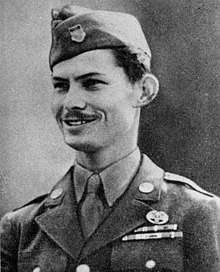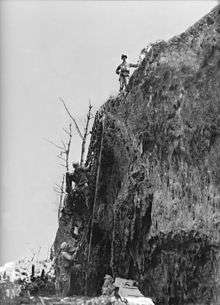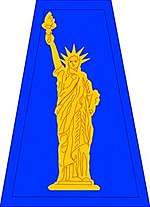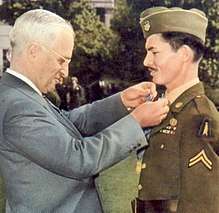Desmond Doss
| Desmond Doss | |
|---|---|
 Doss about to receive the Medal of Honor in October 1945 | |
| Birth name | Desmond Thomas Doss |
| Nickname(s) | Preacher |
| Born |
February 7, 1919 Lynchburg, Virginia, U.S. |
| Died |
March 23, 2006 (aged 87) Piedmont, Alabama, U.S. |
| Allegiance |
|
| Service/ |
|
| Years of service | 1942–1946 |
| Rank |
|
| Service number | 33158036 |
| Unit |
|
| Battles/wars |
World War II |
| Awards |
|
| Spouse(s) |
|
| Children | Desmond T. Doss, Jr. |
Desmond Thomas Doss (February 7, 1919 – March 23, 2006)[1] was a United States Army corporal who served as a combat medic with an infantry company in World War II. He was twice awarded the Bronze Star Medal for actions in Guam and the Philippines. Doss further distinguished himself in the Battle of Okinawa by saving 75 men,[lower-alpha 1] becoming the only conscientious objector to receive the Medal of Honor for his actions during the Second World War.[lower-alpha 2] His life has been the subject of books, the documentary The Conscientious Objector, and the critically acclaimed 2016 film Hacksaw Ridge.
Early life
Desmond Doss was born in Lynchburg, Virginia, to William Thomas Doss (1893–1989),[3] a carpenter, and Bertha Edward Doss (née Oliver) (1899–1983),[4] a homemaker and shoe factory worker.[5][6][7] His mother raised him as a devout Seventh-day Adventist and instilled Sabbath-keeping, nonviolence, and a vegetarian lifestyle in his upbringing.[8] He grew up in the Fairview Heights area of Lynchburg, Virginia, alongside his older sister Audrey and younger brother Harold.[7]
Doss attended the Park Avenue Seventh-day Adventist Church school until the eighth grade, and subsequently found a job at the Lynchburg Lumber Company to support his family during the Great Depression.[7]
World War II service

Before the outbreak of World War II, Doss was employed as a joiner at a shipyard in Newport News, Virginia.[7] Doss entered military service, despite being offered a deferment for his shipyard work,[9] on April 1, 1942, at Camp Lee, Virginia.[10] He was sent to Fort Jackson in South Carolina for training with the reactivated 77th Infantry Division. Meanwhile, his brother Harold served aboard the USS Lindsey.[11]
Doss refused to kill an enemy soldier or carry a weapon into combat because of his personal beliefs as a Seventh-day Adventist.[12] He consequently became a medic assigned to 2nd Platoon, B Company, 1st Battalion, 307th Infantry, 77th Infantry Division.
While serving with his platoon in 1944 on Guam and the Philippines, he was awarded two Bronze Star Medals with a "V" device,[13] for exceptional valor in aiding wounded soldiers under fire. During the Battle of Okinawa, he saved the lives of 50–100 wounded infantrymen atop the area known by the 96th Division as the Maeda Escarpment or Hacksaw Ridge.[14] Doss was wounded four times in Okinawa,[15] and was evacuated on May 21, 1945, aboard the USS Mercy.[16] Doss suffered a left arm fracture from a sniper's bullet and at one point had seventeen pieces of shrapnel embedded in his body.[16] He was awarded the Medal of Honor for his actions in Okinawa.
Life postwar

After the war, Doss initially planned to continue his career in carpentry, but extensive damage to his left arm made him unable to do so.[7] In 1946, Doss was diagnosed with tuberculosis, which he had contracted on Leyte.[16] He underwent treatment for five and a half years – which cost him a lung and five ribs – before being discharged from the hospital in August 1951 with 90% disability.[17][18]
Doss continued to receive treatment from the military, but after an overdose of antibiotics rendered him completely deaf in 1976, he was given 100% disability; he was able to regain his hearing after receiving a cochlear implant in 1988.[5][16] Despite the severity of his injuries, Doss managed to raise a family on a small farm in Rising Fawn, Georgia.[16]
Doss married Dorothy Pauline Schutte on August 17, 1942, and they had one child, Desmond "Tommy" Doss Jr., born in 1946.[16] Dorothy died on November 17, 1991, from a car accident.[16] Doss remarried on July 1, 1993, to Frances May Duman.[5][1]
After being hospitalized for difficulty breathing, Doss died on March 23, 2006, at his home in Piedmont, Alabama.[19] He was buried on April 3, 2006, in the National Cemetery in Chattanooga, Tennessee.[20]
Awards and decorations
Medal of Honor

Rank and organization: Private First Class, United States Army, Medical Detachment, 307th Infantry, 77th Infantry Division.
Place and date: Near Urasoe Mura, Okinawa, Ryukyu Islands, April 29, 1945 – May 21, 1945.
Entered service at: Lynchburg, Virginia
Birth: Lynchburg, Virginia
G.O. No.: 97, November 1, 1945.
Corporal Doss receiving the Medal of Honor from President Harry S. Truman on October 12, 1945The President of the United States of America, authorized by Act of Congress, March 3, 1863, has awarded in the name of The Congress the MEDAL OF HONOR to
PRIVATE FIRST CLASS DESMOND T. DOSS
UNITED STATES ARMY
for service as set forth in the following
Citation: Private First Class Desmond T. Doss, United States Army, Medical Detachment, 307th Infantry, 77th Infantry Division. Near Urasoe-Mura, Okinawa, Ryukyu Islands, 29 April – 21 May 1945. He was a company aid man when the 1st Battalion assaulted a jagged escarpment 400 feet high. As our troops gained the summit, a heavy concentration of artillery, mortar and machinegun fire crashed into them, inflicting approximately 75 casualties and driving the others back. Private First Class Doss refused to seek cover and remained in the fire-swept area with the many stricken, carrying them one by one to the edge of the escarpment and there lowering them on a rope-supported litter down the face of a cliff to friendly hands. On 2 May, he exposed himself to heavy rifle and mortar fire in rescuing a wounded man 200 yards forward of the lines on the same escarpment; and two days later he treated four men who had been cut down while assaulting a strongly defended cave, advancing through a shower of grenades to within eight yards of enemy forces in a cave's mouth, where he dressed his comrades' wounds before making four separate trips under fire to evacuate them to safety. On 5 May, he unhesitatingly braved enemy shelling and small arms fire to assist an artillery officer. He applied bandages, moved his patient to a spot that offered protection from small-arms fire and, while artillery and mortar shells fell close by, painstakingly administered plasma. Later that day, when an American was severely wounded by fire from a cave, Private First Class Doss crawled to him where he had fallen 25 feet from the enemy position, rendered aid, and carried him 100 yards to safety while continually exposed to enemy fire. On 21 May, in a night attack on high ground near Shuri, he remained in exposed territory while the rest of his company took cover, fearlessly risking the chance that he would be mistaken for an infiltrating Japanese and giving aid to the injured until he was himself seriously wounded in the legs by the explosion of a grenade. Rather than call another aid man from cover, he cared for his own injuries and waited five hours before litter bearers reached him and started carrying him to cover. The trio was caught in an enemy tank attack and Private First Class Doss, seeing a more critically wounded man nearby, crawled off the litter and directed the bearers to give their first attention to the other man. Awaiting the litter bearers' return, he was again struck, this time suffering a compound fracture of one arm. With magnificent fortitude he bound a rifle stock to his shattered arm as a splint and then crawled 300 yards over rough terrain to the aid station. Through his outstanding bravery and unflinching determination in the face of desperately dangerous conditions Private First Class Doss saved the lives of many soldiers. His name became a symbol throughout the 77th Infantry Division for outstanding gallantry far above and beyond the call of duty.
October 12, 1945
THE WHITE HOUSE[21]
Other awards and decorations
Including the Medal of Honor, Doss' awards are:[22]
 | |||||
 | |||||
| Combat Medical Badge | |||||
| Medal of Honor | Bronze Star Medal with one Oak leaf cluster and "V" Device | ||||
| Purple Heart with two Oak leaf Clusters |
Army Good Conduct Medal | American Campaign Medal | |||
| Asiatic–Pacific Campaign Medal with arrowhead device and three 3⁄16" bronze stars |
World War II Victory Medal | Philippine Liberation Medal with one 3⁄16" bronze service star | |||
| Army Presidential Unit Citation | Meritorious Unit Commendation | ||||
| 77th Infantry Division SSI-FWTS | |||||
Other honors and recognition


- A portion of US Route 501 near Peaks View Park is named "Pfc. Desmond T. Doss Memorial Expressway." Local veterans of the area honor him by decorating the signs marking this portion of road several times during the year, particularly around patriotic holidays.[23]
- In 1951, Camp Desmond T. Doss was created in Grand Ledge, Michigan to help train young Seventh-day Adventist men for service in the military. The camp was active throughout the Korean and Vietnam wars before the property was sold in 1988.[24]
- In the early 1980s, a school in Lynchburg was renamed Desmond T. Doss Christian Academy. The school was founded by the Lynchburg Seventh-Day Adventist Church, the home church of Desmond Doss during his years in Lynchburg. The church wanted to honor Doss for standing strong in his faith despite facing great adversity.[25] Doss visited the school that bears his name three times before his death.[26]
- On July 10, 1990, a section of Georgia Highway 2 between US Highway 27 and Georgia Highway 193 in Walker County was named the "Desmond T. Doss Medal of Honor Highway."[27]
- On March 20, 2000, Doss appeared before the Georgia House of Representatives and was presented a special resolution honoring his heroic accomplishments on behalf of the country.[28]
- On July 4, 2004, a statue of Doss was dedicated at the National Museum of Patriotism in Atlanta, Georgia, which remained until the museum's closure in July 2010.[5]
- In May 2007, a statue of Doss was dedicated at Veterans Memorial Park in Collegedale, Tennessee.[29]
- In July 2008, the guest house at Walter Reed Army Medical Center in Washington, D.C., was renamed Doss Memorial Hall.[30]
- On August 30, 2008, a two-mile stretch of Alabama Highway 9 in Piedmont was named the "Desmond T. Doss Sr. Memorial Highway."[31]
- On October 25, 2016, the City of Lynchburg, Virginia, awarded a plaque in his honor to Desmond T. Doss Christian Academy.[32]
- On February 7, 2017, PETA posthumously honored Doss with a Hero to Animals award in recognition of his lifelong commitment to vegetarianism.[33]
In media
Television and cinema
On February 18, 1959, Doss appeared on the Ralph Edwards NBC TV show This Is Your Life.[34]
Doss is the subject of The Conscientious Objector, an award-winning documentary by Terry Benedict in 2004.[35]
The feature film Hacksaw Ridge, based on his life, was produced by Terry Benedict and directed by Mel Gibson. The film was released nationwide in the U.S. on November 4, 2016 to positive reviews. Doss is portrayed by Andrew Garfield, who was nominated for an Academy Award for Best Actor for his performance. Desmond's wife, Dorothy, is played by Teresa Palmer.
Doss was profiled in a three part TV series by It Is Written in November 2016.[36]
Doss is the subject of four biographical books:
- The Unlikeliest Hero; The Story of Desmond T. Doss, Conscientious Objector Who Won His Nation's Highest Military Honor, 1967 by Booton Herndon[17]
- Desmond Doss Conscientious Objector: The Story of an Unlikely Hero, 2015 by Francess M Doss[37]
- Redemption At Hacksaw Ridge: The Gripping True Story That Inspired The Movie, 2016 by Booton Herndon[38]
- The Birth of Hacksaw Ridge: How It All Began, 2017 by Gregory Crosby and Gene Church[39]
Doss has been featured in major publications and media including:
- Time Magazine[40]
- NPR[41]
- People Magazine[6]
- Library of Congress[42]
- Pritzker Military Museum & Library[43]
Doss was featured in the Medal of Honor Special comic written by Doug Murray and published by Dark Horse Comics. The comic was a special edition of the series Medal of Honor, published April 1, 1994. The title was sanctioned by the United States Congressional Medal of Honor Society.[44] The issue features Corporal Desmond Doss along with another Medal of Honor recipient, Lieutenant Charles Q. Williams.[45]
See also
Notes
- ↑ Although the exact number is unknown, estimates range from 50 to 100 since 55 of the 155 soldiers involved in the action were able to retreat without assistance.[2]
- ↑ Conscientious objectors Thomas W. Bennett and Joseph G. LaPointe Jr. were posthumously awarded the Medal of Honor during the Vietnam War.
References
- 1 2 Bernstein, Adam (March 26, 2006). "Lauded Conscientious Objector Desmond T. Doss Sr". Washington Post. ISSN 0190-8286. Archived from the original on December 15, 2017. Retrieved February 5, 2018.
- ↑ "Desmond T. Doss". HomeOfHeroes.com. Archived from the original on November 19, 2016. Retrieved January 10, 2017.
- ↑ "William Thomas Doss". Geni.com. Archived from the original on July 28, 2017. Retrieved July 28, 2017.
- ↑ "Bertha Edward Doss". Geni.com. Archived from the original on July 28, 2017. Retrieved July 28, 2017.
- 1 2 3 4 "Desmond T. Doss". collegedale-americanlegion.org. Archived from the original on 2014-11-29. Retrieved November 20, 2014.
- 1 2 "The True Story of Hacksaw Ridge and Desmond Doss: the Medal of Honor Winner Who Never Fired a Shot". People. November 5, 2016. Archived from the original on January 18, 2017.
- 1 2 3 4 5 "Desmond Doss, an American hero". November 5, 2016.
- ↑ Military.com, "Seventh-Day Adventist Saved Fellow Soldiers on Sabbath". Archived from the original on August 11, 2001. Retrieved 2017-05-19. Retrieved January 10, 2017.
- ↑ "The Conscientious Objector". March 2004. Archived from the original on 2017-01-14.
- ↑ "WWII Army Enlistment Records". National Archives. Archived from the original on June 20, 2015. Retrieved June 30, 2005.
- ↑ "In Memory of Harold Edward Doss". Brown Funeral Home. Archived from the original on March 4, 2016. Retrieved August 1, 2015.
- ↑ "Who was Desmond Doss of Hacksaw Ridge". Bibleinfo.com. Archived from the original on December 1, 2016. Retrieved December 2, 2016.
- ↑ "bronze star Archives – Faith Of Doss". Faith Of Doss. Archived from the original on September 25, 2017. Retrieved September 25, 2017.
- ↑ Appleman; Burns; Giegler; Stevens. "Chapter XI Assaulting The Second Shuri Defense Ring". HyperWar: US Army in WWII: Okinawa: The Last Battle. Archived from the original on March 9, 2017. Retrieved June 3, 2017.
- ↑ "Private First Class Desmond T. Doss Interview". March 20, 1987. Archived from the original on November 8, 2016.
- 1 2 3 4 5 6 7 "Hacksaw Ridge (2016)". HistoryvsHollywood.com. Archived from the original on November 18, 2016. Retrieved November 7, 2016.
- 1 2 Herndon, Booton (1967). The Unlikeliest Hero: The Story of Desmond T. Doss, Conscientious Objector, who Won His Nation's Highest Military Honor. Boise, Idaho: Pacific Press Publishing Association. p. 182. ISBN 978-0-8163-2048-6. Archived from the original on 2018-02-06.
- ↑ "This is Your Life – Desmond Doss". February 18, 1959. Archived from the original on November 29, 2016.
- ↑ Richard Goldstein (March 25, 2006). "Desmond T. Doss, 87, Heroic War Objector, Dies". New York Times. Archived from the original on June 19, 2016. Retrieved June 16, 2013.
- ↑ "'Unlikeliest Hero' buried with 21-gun salute". Associated Press. NBC News. April 4, 2006. Archived from the original on September 27, 2016.
- ↑ "The Medal of Honor". desmonddoss.com. Archived from the original on July 31, 2017. Retrieved July 31, 2017.
- ↑ Herndon, Booton (2016). Redemption at Hacksaw Ridge. Remnant Publications. p. Foreword. ISBN 978-1-629131-55-9. Archived from the original on 2018-02-06.
- ↑ "Memorial ride honors Lynchburg military hero Desmond Doss". November 2, 2016. Archived from the original on March 16, 2017.
- ↑ Judy Putnam (February 28, 2017). "Camp Doss in Grand Ledge named for war hero in 'Hacksaw Ridge'". Lansing State Journal. Retrieved March 1, 2017.
- ↑ "History of Desmond Doss". Desmond T. Doss Christian Academy. Archived from the original on October 21, 2016. Retrieved August 16, 2016.
- ↑ "Remembering visits from Mr. Desmond T. Doss, the man for whom our school is named – Desmond T. Doss Christian Academy". May 17, 2016. Archived from the original on August 13, 2016.
- ↑ "Walker County". Calhoun Times. September 1, 2004. p. 108. Retrieved April 26, 2015.
- ↑ "HR 206 – Doss, Desmond T.; invite to House – Fulltext". March 14, 2000. Archived from the original on August 3, 2016.
- ↑ "Desmond Doss Sculpture Unveiled at Veterans Memorial Park". Adventist Review. uccsda.org. May 14, 2007. Archived from the original on August 7, 2008.
- ↑ "Guest House named after Medal of Honor recipient". WRAMC News Releases. July 17, 2008. Archived from the original on June 15, 2011. Retrieved August 31, 2008.
- ↑ Debra Flax (May 26, 2013). "Warrior without a weapon: Remembering Desmond Doss Sr". The Anniston Star. Archived from the original on December 1, 2017. Retrieved November 22, 2017.
- ↑ "Desmond Doss' Hacksaw Ridge Heroics and School Honored". October 30, 2016. Archived from the original on October 31, 2016.
- ↑ "PETA awards Lynchburg hero Desmond Doss the Hero to Animals award". February 7, 2017. Archived from the original on February 13, 2017.
- ↑ "This Is Your Life Episode List". Jim Davidson's Classic TV Info. Archived from the original on March 24, 2008. Retrieved September 12, 2016.
- ↑ "The Conscientious Objector". imdb.com. Archived from the original on October 25, 2012. Retrieved January 29, 2013.
- ↑ "Series on the Hero of Hacksaw Ridge". Hope Channel. October 31, 2016. Archived from the original on September 25, 2017.
- ↑ Doss, Francess M. (22 September 2015). "Desmond Doss Conscientious Objector: The Story of an Unlikely Hero". Pacific Press Publishing Association – via Amazon.
- ↑ Herndon, Booton (1 November 2016). "Redemption At Hacksaw Ridge: The Gripping True Story That Inspired The Movie". Remnant Publications – via Amazon.
- ↑ Crosby, Gregory (13 November 2017). "The Birth of Hacksaw Ridge: How It All Began". Make-Believe Entertainment. Archived from the original on 22 December 2017 – via Blurb.
- ↑ Berman, Eliza (November 3, 2016). "The True Story Behind 'Hacksaw Ridge'". Time. Archived from the original on October 4, 2017.
- ↑ "The Real 'Hacksaw Ridge' Soldier Saved 75 Souls Without Ever Carrying A Gun". NPR. November 4, 2016. Archived from the original on September 25, 2017.
- ↑ "Desmond Thomas Doss collection: Veterans History Project (Library of Congress". memory.loc.gov. October 26, 2011. Archived from the original on September 25, 2017.
- ↑ "Beyond glory: Medal of Honor heroes in their own words: extraordinary stories of courage from World War II to Vietnam". pritzkermilitary.org. Archived from the original on October 1, 2017. Retrieved October 1, 2017.
- ↑ "Medal of Honor Special". Dark Horse Comics. Archived from the original on April 17, 2015. Retrieved September 17, 2014.
- ↑ "Medal of Honor Special". Pritzker Military Museum & Library. Archived from the original on February 10, 2015. Retrieved September 17, 2014.
Further reading
- Herndon, Booton (2016). Hero of Hacksaw Ridge: The Gripping True Story That Inspired the Movie. Cold Water, Michigan: Remnant Publications. ISBN 978-1-629131-54-2.
- Leepson, Marc (2008), "Wonder Man of Okinawa," Military History magazine, September/October 2008, Vol. 25, No. 4.
- Herndon, Booton (2004). The Unlikeliest Hero: The Story of Desmond T. Doss, Conscientious Objector Who Won His Nation's Highest Military Honor. Mountain View, California: Pacific Press Publishing Association. ISBN 978-0-8163-2048-6.
- Doss, Frances M. (2005). Desmond Doss: Conscientious Objector. Pacific Press Publishing Association. ISBN 978-0-8163-2124-7.
- Doss, Frances M. (1998). Desmond Doss: In God's care: The unlikeliest hero and Congressional Medal of Honor recipient. The College Press.
- Smith, Larry (2003). Beyond Glory: Medal of Honor Heroes in Their Own Words. Norton. ISBN 039305134X.
External links
- "Official Desmond Doss Website". Retrieved July 28, 2016.
- Desmond Doss at Find a Grave
- The Conscientious Objector on IMDb
- "North America: Filmmaker Documents Story of Desmond Doss". Adventist News Network. November 18, 2003.
- "Desmond T. Doss Christian Academy, a Seventh-Day Adventist school in Lynchburg, Virginia". Retrieved September 29, 2010.
- "Obituaries:Desmond Thomas Doss, Sr., MOH". Retrieved May 8, 2016.
- ^ "Medal of Honor recipients World War II (A–F)". United States Army Center of Military History
- "Burial Set April 3 At National Cemetery For Medal of Honor Winner Desmond Doss". The Chattanoogan.
- Leepson, Marc (2015). "Desmond Thomas Doss (1919–2006)", Dictionary of Virginia Biography, Library of Virginia (1998–)
- Soper, Matthew (April 2002). "Desmond Doss: A War Hero Without a Gun". Incredible People Magazine.

